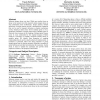Free Online Productivity Tools
i2Speak
i2Symbol
i2OCR
iTex2Img
iWeb2Print
iWeb2Shot
i2Type
iPdf2Split
iPdf2Merge
i2Bopomofo
i2Arabic
i2Style
i2Image
i2PDF
iLatex2Rtf
Sci2ools
148
Voted
ESEM
2010
ACM
2010
ACM
Object oriented design pattern decay: a taxonomy
Software designs decay over time. While most studies focus on decay at the system level, this research studies design decay on well understood micro architectures, design patterns. Formal definitions of design patterns provide a homogeneous foundation that can be used to measure deviations as pattern realizations evolve. Empirical studies have shown modular grime to be a significant contributor to design pattern decay. Modular grime is observed when increases in the coupling of design pattern classes occur in ways unintended by the original designer. Further research is necessary to formally categorize distinct forms of modular grime. We identify three properties of coupling relationships that are used to classify subsets of modular grime. A taxonomy is presented which uses these properties to group modular grime into six disjoint categories. Illustrative examples of grime build-up are provided to demonstrate the taxonomy. A pilot study is used to validate the taxonomy and provide ini...
Related Content
| Added | 06 Dec 2010 |
| Updated | 06 Dec 2010 |
| Type | Conference |
| Year | 2010 |
| Where | ESEM |
| Authors | Travis Schanz, Clemente Izurieta |
Comments (0)

